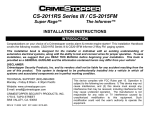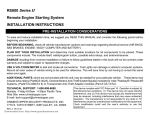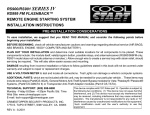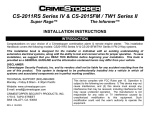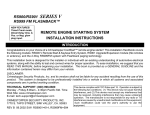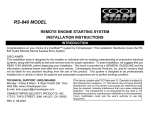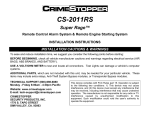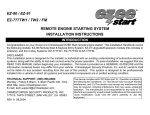Download Command Start CS-580i FM Owner`s manual
Transcript
CS-2011RS Series II / CS-2015FM Super Rage™ The Informer™ INSTALLATION INSTRUCTIONS PRE-INSTALLATION CONSIDERATIONS To ease the installation, we suggest that you READ THIS MANUAL and consider the following points before beginning your installation. BEFORE BEGINNING, check all vehicle manufacturer cautions and warnings regarding electrical service (AIR BAGS, ABS BRAKES, ENGINE / BODY COMPUTER AND BATTERY). PLAN OUT YOUR INSTALLATION. You should pre-determine the location of the Control Module (Brain), Valet button, LED, and Siren locations. This will save time and ease the installation process. USE A VOLT/OHM METER to test and locate all connections. Test Lights or Lighted Probes could possibly damage a vehicle’s computer system or cause an airbag to deploy. ADDITIONAL PARTS, that are not included with this unit, may be needed for your particular vehicle. These items may include extra relays (Part#CS-402A), General Motors Anti-Theft System Bypass modules for Vats / Passkey® / Passlock® Systems, (Part# CS-GMATA II) or Transponder Anti-Theft Adapter modules (Part # CS-TATA). TECHNICAL SUPPORT (800)-998-6880 Monday - Friday 8:00am - 4:30pm Pacific Website: www.crimestopper.com E-mail: [email protected] CRIMESTOPPER SECURITY PRODUCTS, INC. 1770 S. TAPO STREET SIMI VALLEY, CA. 93063 REV C 10.2001 S/W: 580 This device complies with FCC Rules part 15. Operation is subject to the following two conditions: 1) This device may not cause interference, and (2) this device must accept any interference that may be received, including interference that may cause undesired operation. The manufacturer is not responsible for any radio or TV interference caused by unauthorized modification to this equipment. Such modification could void the user's authority to operate the equipment. TABLE OF CONTENTS Pre-Installation Considerations………………………...……...………………………………………………………Front Cover Cautions & Warnings…….……………………………..…..………………………………………………………………………2 Component Mounting………….………………………..……………………………………………….…………………..……..3 Wiring……..…………………………………………………....…………………………………………………………….…….3-9 Power Door Lock Wiring...………………………………………………………….………….……..…………...……………9-12 Smart Tachless, Tach Reference, & Tach Finder Modes…………………………………………………………………13-14 Transmitter / Transceiver Programming…………………………….………………….…………………………...…...….14-15 Programmable Options……...………………………………………….……………………………….………….…………15-18 Diagnostics……………………………………..……………………………………………………………………….………….18 Remote Start Troubleshooting…….……………………..………………………………………………………………...…….19 System Wiring Diagram…………………………………………………………………………………………………...………20 CAUTIONS & WARNINGS DAMAGE RESULTING FROM IMPROPER INSTALLATION IS NOT COVERED UNDER WARRANTY!! DO NOT remote start the vehicle in a closed garage. Make sure that the garage door is open or there is adequate ventilation. Failure to observe this rule could result in injury or death from poisonous Carbon Monoxide fumes. DO NOT ROUTE ANY WIRING THAT MAY BECOME ENTANGLED with the brake/gas pedals, steering column, or any other moving parts in the vehicle. ALLOW ENOUGH WIRE to create a service loop. Once the installation is complete, a service loop allows access to the system for adding accessories, wiring, or troubleshooting. REMOVE MAIN SYSTEM FUSE(S) before jump-starting the vehicle or charging the battery at high boost. DAMAGE MAY OCCUR TO SYSTEM IF PROPER PRECAUTIONS ARE NOT OBSERVED. DO NOT exceed the rated output current of any circuit on the Remote start module. Failure to observe this warning will result in damage to the unit. Output currents are listed where applicable throughout this manual. DO NOT extend the Remote start ignition harness length. Mount the module so that main harness reaches all ignition switch wiring. Extending these wires could result in poor performance. COMPONENT MOUNTING CONTROL MODULE: The alarm control module should be mounted in a concealed location. DO NOT mount the control unit in the engine compartment. Fasten the module to a bracket or wire harness using the cable ties provided. ANTENNA MODULE: For optimum range and performance, the antenna/receiver module should be located high up on the front windshield glass. For example: behind the rearview mirror. Note: Window tints or Films may decrease the range of the system. The mounting surface for the antenna should be clean and dry. SIREN MOUNTING: Mount the siren under the hood to fender-well or other body surface with the open end facing downward. Run the red siren wire through the firewall using a rubber grommet. Ground the black wire to the body metal near the siren. LED: Mount the red LED in a visible location on the dashboard or console. SHOCK SENSOR: Mount the included shock sensor with wire ties to an under dash wire harness or fasten with screws to firewall or side paneling. OVERRIDE/PROGRAM/VALET BUTTON: Mount the Override/Program push-button in a hidden but accessible location. This button is required for emergency disarm, programming, and valet mode. WIRING: 9-PIN Harness Green: (-) Start Activation Trigger Input This wire allows an outside source or accessory to activate a Remote Start. A 1-second Ground pulse on this wire will trigger a remote start. This wire can be used with optional accessories. Brown: (+) Siren Output Connect brown wire to siren red wire. Connect black wire of siren to chassis ground (body metal). Brown/White: (-) Horn Honk Output (Optional, may require a relay) Connect to the Negative Horn Trigger wire usually located near the steering column. If the vehicle horn circuit requires +12V, then a relay is required. RELAY WIRING: Connect the Brown/White wire to terminal 85, connect relay terminals 86 and 87 to +12V constant power. Connect terminal 30 of the relay to the +12V positive device/circuit to be activated. Black/White: (-) 500mA Dome Light Illumination Output (Optional, Requires relay) Negative Dome Light System: Connects to terminal 85 of a relay. Connect terminals 86 +12V Constant. Connect terminal 87 to Chassis Ground and Connect Terminal 30 to the Negative dome light activation circuit. Positive Dome Light System: Connects to terminal 85 of a relay. Connect terminals 86 & 87 to +12V Constant. Connect terminal 30 to the Positive dome light activation circuit. WIRING: 9-PIN Harness Green/Red: Remote Aux. Output 1 OR MAP-Mobile Accessories Protection (Optional, requires relay) This is a programmable output that can operate two different ways: 1. (DEFAULT) A Remote Auxiliary Output that provides a ½ Second (-) Negative pulse when Button #3 is pressed to open a Factory power trunk or hatch release. It can function as an MAP output that provides a continuous (-) Negative output when in the system is put into VALET PARK MODE. M.A.P. can be used to interrupt power/accessory wiring to prevent unauthorized access of the vehicle’s audio or entertainment systems when Valet Park mode is ON. See Mobile Accessories Protection Diagram Below. GREEN/RED M.A.P. OUTPUT 85 86 87 + IGN. SWITCHED 87A 30 MOBILE ACCESSORY PROTECTION Connect relay as shown to interrupt the power wire of mobile accessories such as Audio system or Cellular telephone. The Alarm will disconnect these accessories when in VALET PARK MODE. OFF 105. 5 FM ACC IGN CUT START RADIO Blue/Black: (-) Remote Aux. Output 2 (Optional, may require relay) This wire provides a Momentary (-) Negative output when Button #3 (Trunk) is pressed and held for more than 2 seconds. Output stays on as long a remote button is held down. Connect to the Negative activation circuit of an auxiliary module or device. If the circuit requires +12V, then a relay is required. RELAY WIRING: Connect the Blue/Black wire to terminal 85, connect relay terminals 86 and 87 to +12V constant power. Connect terminal 30 of the relay to the +12V positive device/circuit to be activated. Blue/White: (-) Passenger Door Unlock Output (Optional, requires relay) This wire activates when the unlock button on the remote is pressed a second time upon disarming. Connects to unlock circuit for passenger door or doors when using special driver’s door unlock configuration. See DOOR LOCK WIRING for special configuration options. Orange: (-) Negative Starter Disable / Anti-Grind Output This wire should be connected to the Yellow wire of the pre-wired relay socket for the starter disable. Connect the blue wire of the relay socket to the Ignition switched wire on the vehicle. Cut the vehicle starter wire and connect each half to an Orange wire on the relay socket. This output is called Anti-Grind because it stays active during remote start preventing the starter from grinding if the key is turned too far after the vehicle is running. See diagram on next page. WIRING: 9-PIN Harness Orange: (-) Negative Starter Disable / Anti-Grind Output IGNITION SWITCHED "ON" & HOT THROUGH CRANKING IGN. SWITCHED STARTER WIRE CONNECT TO ORANGE WIRE OF ALARM CUT YELLOW STARTER PRE-WIRED STARTER DISABLE RELAY & SOCKET BLUE ORANGE MAKE CERTAIN TO CONNECT BROWN WIRE TO STARTER MOTOR SIDE!!! ORANGE START OUTPUT FROM ALARM 6-PIN HARNESS BROWN Orange/Black: (-) OEM Disarm Output This wire provides a Ground pulse to disarm vehicles' Factory anti-theft system prior to a Remote Start. Connect this wire to the vehicles' anti-theft disarm wire. This wire is sometimes found coming off the Driver's door key switch or at the Factory Anti-theft control module. WIRING: 6-PIN High Current Connector PIN 1: BROWN: STARTER OUTPUT (30A) PIN 2: GRAY: ACCESSORY or IGNITION 2 (30A) PIN 3: RED: BATTERY CONSTANT FUSED (30A) PIN 4: RED: BATTERY CONSTANT FUSED (30A) PIN 5: PINK: IGNITION 1 (30A) PIN 6: WHITE (18 Ga.): (+) PARKING LIGHTS (10A) NOTE!: Use External Relays for High Current Ignition and/or Accessory circuits greater than 30A. Failure to do so could result in damage to the unit that is not covered under warranty. CAUTION!: CHECK ALIGNMENT OF PLUG TO PINS. IF THE HARNESS IS UPSIDE DOWN, STARTER OUTPUT WILL BE CONNECTED TO PARKING LIGHTS! WIRING: 6-PIN High Current Connector This diagram is provided as a guide. Your vehicle may differ. PARKING LIGHTS RED WHITE FUSE 30A RED +10A MAX. FUSE 30A + FUEL PUMP + - ENGINE ECU PINK BROWN GRAY BATTERY STARTER COIL IGN 1 HEAT/AC ACC NOTE!: Use External Relays for High Current Ignition and/or Accessory circuits greater than 30A. Failure to do so could result in damage to the unit that is not covered under warranty. - WIRING: 4-PIN Harness Red/White: Tachometer Input When installing this system in TACH REFERENCE mode, this wire must be connected to a valid source of AC voltage. This wire allows the unit to sense the engine running. See Tach Reference Section on Pg. 13 for more information. Black: Chassis Ground Connect to body metal of the vehicle using a sheet metal screw and a star washer to ensure a good ground. Keep the Ground wire short. Scrape away and paint or debris from ground location. Yellow/White: (-) Accessory Output (For Adding Accessory or IGN2 Relays) Yellow: (-) Ignition 1 Output (For Adding Ignition Relays OR Anti-Theft Bypass Module) Use these wires when the vehicle requires a second IGNITION 1, IGNITION 2, or ACCESSORY wire to be activated. This occurs commonly in Toyota, and late model GM cars. Use these wires for activation of Anti-Theft Modules for GM or Transponders. Use a CS-GMATA for GM Vehicles, CS-TATA for Transponder Keys. See diagram below. ANTI-THEFT OR YELLOW OR (YELLOW/WHITE) MODULE 85 86 30 87 + BATTERY 2nd IGN 1 OR (2nd IGN2 /ACC WITH YEL/WHT) IGN SW. WIRING: 5-PIN Harness Violet: (+) Door Pin Switch Input Same as the GREEN wire below except this wire is used for vehicles that show a positive voltage (12 volts) when the door is open and a ground when doors are closed as in many Ford, Lincoln, and Mercury vehicles. Green: (-) Door Pin Switch Input Identify the wire that reads ground when any door is open and 12 volts when all doors are closed. Some vehicles may have isolated door triggers. In this case you may need to run additional wires from other doors or go directly to the wire that triggers the vehicle’s interior dome light. Sometimes newer vehicles contain a separate body control module (BCM) where the door trigger circuit can be located. Most vehicles will NOT require the use of BOTH Green and Violet door trigger wires. WIRING: 5-PIN Harness Blue: (-) Hood/Trunk Pin Switch Input Input trigger for a grounding hood or trunk pin switch. Connect to existing hood and trunk pin switches that read ground when open. If no existing switches are available, install new pin switches if desired. Note: DO NOT mount new pin switches in water pathways. The kit includes a pre-terminated 6” brown wire end for connecting to the supplied hood pin switch terminal. Pink: (+12V) Diesel Glow Plug Input or Car Jack Input (Programmable Input Wire) Glow Plug (Diesel): Connect to the indicator circuit that shows +12 volts while the “WAIT TO START LAMP” is on. When this wire is used, the system will wait until the light turns off before attempting a remote start. Note: An inverter module or relay can be used for vehicles that have a Negative wait to start lamp circuit. Carjack Trigger When using Carjack protection, connect this Pink wire to a toggle switch, or positive door trigger or ignition depending on your level of Carjack protection. When +12V is applied to this wire, with the IGN on, then Carjack is armed. If a door is opened then closed, a Carjack countdown will begin. See Diagram Below for wiring configurations. DO NOT connect the Pink Carjack wire to Ignition unless there is extreme danger of a Carjack. When using the Ignition, Carjack is armed all the time and must be reset each time a door is opened and closed. OPTIONAL CAR JACK WIRING: HIDDEN BUTTON or TOGGLE SWITCH (Not Included) PINK IGN SW + IGN + CONTROLLED W/SWITCH 12 V PINK FULL-TIME CARJACK White: (+12V) Brake Reset Connect the White wire to the side of brake pedal switch that shows +12 volts ONLY when pedal is depressed. This will turn off the remote start if someone attempts to drive the car without the keys or if the Ignition key is not turned on all the way. WIRING: 2-PIN LED / 2-PIN Program-Valet Button (22 gauge wires) Mount LED in a visible location in the Dash or Console. Connect the small 2-pin plug from the LED to the control module. Note: Connectors are designed so that they will only plug into their appropriate slots. Mount the Valet/Program/Override button in a suitable location. Connect the 2-pin plug from the Switch to the control module. Note: Connectors are designed so that they will only plug into their appropriate slots. WIRING: 4-PIN Shock Sensor (22 Gauge wires) 4 Pin Plug - Sensor Plug 22 Gauge : White Wire: (-) Negative Trigger Blue Wire: (-) Negative Warn Away Black Wire: (-)Sensor Ground Red Wire: +12Volt Sensor Power SHOCK SENSOR: The sensor supplied with this system does not require any additional wiring. Simply mount the sensor in a suitable location, plug it in, and adjust the sensitivity. Sensor Adjustment Adjust the main shock sensor with the small black dial. Clockwise will increase sensitivity and counter-clockwise will decrease sensitivity. Adjust Pre-Warning level with small White dial. DOOR LOCK WIRING: 3-PIN Harness (22 gauge wires) GREEN: (-) Negative pulse for LOCK BLUE: (-) Negative pulse for UNLOCK RED: +12V Coil Power for external relays HINT: Most Door lock types except for Negative require the use of external Relays or a Relay Module. DETERMINING DOOR LOCK TYPE: We recommend determining the type of locking system the vehicle has before connecting any wires. Incorrect connection could result in damage to the alarm and/or the vehicle’s locking system. We have provided a brief description and test procedure for common door locking systems under “DOOR LOCK SYSTEMS page 10. COMMON DOOR LOCK TYPES: (SEE NEXT PAGE FOR DESCRIPTIONS) Negative Trigger (-): Many Imports, Late Model Ford & General Motors Positive Trigger (+): Many GM, Chrysler/Dodge/Plymouth models: Reverse Polarity: Many Ford/Lincoln/Mercury, Dodge/Chrysler/Plymouth, and some GM Full-size Trucks Single Wire Systems: Late /Chrysler/Dodge/Plymouth models: 95-UP Stratus, Cirrus, Breeze, 96-UP Caravan Voyager, Town & Country; 90-97 Ford Probe; Mazda Semi Automatic: Older Saab and Volvo, Isuzu, Hyundai Electric Vacuum: Many mid 1980’s through mid 1990’s European makes Crimestopper Doorlock Accessories: CS-6600DLM: Dual-relay plug-in module for Reverse Polarity, Positive, or Aftermarket Motors. CS-6500DLI: Plug-in pulse inverter that converts the Negative outputs of the system to Positive type for Positive Door Lock systems. CS-610S1: Aftermarket door lock actuator. (Motor) DOOR LOCKING SYSTEMS NOTE: This door lock information is provided as a guide. Your particular vehicle may differ. Negative Trigger (-): Many Imports; Late model Ford & General Motors Negative trigger door lock systems send a negative (Ground) pulse to existing factory relays to lock and unlock the vehicle doors. Testing with a Volt/Ohm meter or Digital Volt/Ohm Meter (DVM): Attach the red lead to a +12Volt constant power source. Use the Black lead as your testing probe and find the wires that cause the meter to show +12.0 Volts when the lock and unlock buttons on the door panel are pressed. The Negative lock/unlock outputs of this alarm system can be directly interfaced to the lock/unlock wires for most vehicles with Negative type systems. Positive Trigger (+): Many General Motors; Chrysler / Dodge / Plymouth Positive trigger door lock systems send a Positive (12V) pulse to existing factory relays to lock and unlock the vehicle doors. Testing with a Volt/Ohm meter or Digital Volt/Ohm Meter (DVM): Attach the Black lead to Chassis ground (Vehicle body metal). Use the Red lead as your testing probe and find the wire that causes the meter to show +12 Volts when the lock button on the door panel is pressed. Positive systems require external relays or a pulse inverter. Reverse Polarity: Many Ford/Lincoln/Mercury/Dodge/Chrysler/Plymouth and GM Trucks Reverse Polarity systems use no relays, but instead the door lock/unlock motors are controlled directly from the lock and unlock switches in the door. The lock and unlock wires rest at Negative Ground when not in use. When the lock or unlock button is pressed, one of the circuits is “Lifted” and replaced with +12V causing a lock or unlock to happen. Reverse Polarity system require external relays or a relay module. Single Wire (Dual Volt): Ford Probe 1990-97, 1995-UP Chrysler Minivans/Stratus/Cirrus, some 2000-UP GM Dual voltage systems have lock/unlock switches that send varying amounts of Positive voltage OR Negative ground current through resistors to SAME wire for both lock and unlock. When the vehicle’s Body Computer Module (BCM) or door lock module senses different voltages on this wire, the system will either lock or unlock. Single wire door lock systems require external relays or a relay module and resistors. Semi Automatic: European makes and some Imports Saab, Volvo, Isuzu, Hyundai Semi Automatic systems use a power lock control for all doors EXCEPT the Driver’s door. The only way to control lock/unlock on this type of system is to lock or unlock the Driver’s door. There are also NO Lock/Unlock buttons or switches present in this type of system. The only way to gain control of a Semi Automatic system is to install a door lock Actuator (motor) in the Driver’s door. The Actuator will electronically control the drivers for lock and unlock which will cause all doors to now lock and unlock with the alarm. Actuators are available from Crimestopper (Part # CS610S1) at a low cost. Installing actuators can be difficult and time-consuming. (Varies from vehicle to vehicle.) Electric Vacuum Pump: Mid 1980’s through Mid 1990’s European Makes (Mercedes, Audi) These systems use vacuum-operated mechanisms to lock/unlock the doors from a central pump usually located in the trunk. This system can be controlled via the vacuum pump control wire and 2 relays. In some cases, you can also control vacuum systems by adding and actuator to the driver’s door as in Semi-Automatic Systems. DOOR LOCK WIRING NEGATIVE TRIGGER DOORLOCK WIRING POSITIVE TRIGGER DOORLOCK WIRING GREEN RED GREEN RED BLUE FUSED +12V + BLUE 85 86 87 87A 30 FACTORY POWER LOCKING RELAYS L UL REVERSE POLARITY DOOR LOCK WIRING GREEN FUSED +12V + RED BLUE 85 86 87 87A 30 85 86 87 87A 30 MASTER SWITCH + L UL CUT CUT 85 86 87 87A 30 FACTORY POWER LOCKING L UL RELAYS ADDING AFTERMARKET DOOR LOCK MOTORS GREEN RED FUSED +12V + BLUE 85 86 87 87A 30 85 86 87 87A 30 SEPARATE DRIVER’S DOOR UNLOCK WIRING NEGATIVE TRIGGER DOOR LOCKS BLUE/WHITE GREEN RED BLUE DRIVER'S DOOR MOTOR 85 86 87 30 87A L L UL UL FACTORY LOCK RELAYS +12V + FUSED UNLOCK WIRE CUT WIRING FOR REVERSE POLARITY DOOR LOCKS BLUE/WHITE GREEN RED FUSED +12V BLUE MASTER SWITCH + 85 85 86 86 87 87A 30 87 30 87A + L UNLOCK WIRE 86 87 87A 30 CUT UL CUT 85 CUT LOCK WIRE SMART TACHLESS MODE Both the CS2011RS & CS2015FM include a Tach-less engine monitor called “Smart Tachless” mode. When in “Smart Tachless” mode, the module actively monitors the vehicle’s voltage reference each time a remote start is performed. Smart Tachless mode will adjust itself to maintain optimum efficiency over the life of the life of the installation. No special wiring is required for Smart Tachless mode. The Smart Tachless system works from the existing 12V power connection of the unit. CAUTION: DO NOT USE or CONNECT WHITE/RED TACH WIRE FOR SMART TACHLESS MODE! SMART TACHLESS JUMPERS: (Remove Access Door on top of module) The purpose of the jumpers is to reduce the starter cranking time [if needed] when in “Smart Tachless” mode only. To shorten the crank time by one percent remove jumper #P2. Test the unit and see if the decrease is correct. If a shorter crank time is still required, then remove Jumper #P1, which will reduce the cranking time by another percent. Test the unit and see if the decrease is correct. These are the only two “Smart Tachless” adjustments. IMPORTANT SMART TACHLESS NOTE: NOTE: Smart Tachless Mode is NOT guaranteed to work on EVERY vehicle. Occasionally, older vehicles, DualBattery Systems, or out-of-tune vehicles will not operate properly in Smart Tachless Mode. On the rare occasion this was to happen, use a Tach wire and program the unit for Tach (RPM) Reference Mode. TACH (RPM) REFERENCE MODE & TACH FINDER MODE Tach Reference Mode provides reliable remote starting performance though engine speed sensing. When using Tach Reference Mode, the WHITE/RED wire is used for Tach signal [Engine RPM] input. Most modern engines include various points where the Engine Speed [Tach] or A/C signal may be obtained. Tach Signal examples: Negative (-) side of ignition coil, at the Distributor or Ignition Control Module, Coil Pack, Engine Computer, or Crankshaft Sensor. Sometimes Fuel injection solenoids, and Alternator stator pins can be used. These Tach Signal locations mentioned are provided as a guide, your vehicle may differ. Some locations will NOT be a good location for Tach source due to RF noise or Computer Data. Use the TACH FINDER mode to locate a valid tach source. TACH FINDER MODE: This system now includes a Tach Finder mode to assist in locating a valid or viable tach source for your installation. Follow the Tach Finder steps to locate and /or verify a tach signal. When following the steps, the unit will begin to flash the parking lights if you have the White/Red wire connected to a valid tach source. If lights do not flash, then try another wire until you locate a tach signal that will cause the Parking lights to flash. NOTE: On some vehicles equipped with daytime running lights, it may be difficult to see any flashing parking lights. In this case your only notification will be the slight “ticking” sound coming out of the module from the on-board flashing light relay. TACH FINDER & TACH PROGRAMMING STEPS TACH FINDER: 1. 2. 3. 4. 5. 6. Open hood (or Ground the Blue Hood Pin wire if no hood pin is installed) Start Engine with the key. Press the Program button for 2 seconds Lights will begin flashing if the White/Red wire is connected to a valid tach Once Tach is located then turn off engine and close hood to abort. See Tach Reference programming. TACH PROGRAMMING: 1. 2. 3. 4. 5. Open hood (Or Ground Blue wire if no hood pin installed.) Connect WHITE/RED wire to a valid Tach source. Start engine with key. Press program button 5 times, then wait for 5 light flashes. Wait at least one second then push program button again (1) time, you should get a light flash with the button press. This unit is now at option #1-Tach Learning. 6. Press the #2 Unlock Button on remote transmitter. The unit will read and program the Tach source. The lights will flash twice for confirmation. 7. If lights do not flash twice for confirmation, then try another tach source or try the tach finder. PROGRAMMING – CS-2015FM TRANSCEIVER / CS-2011RS TRANSMITTER Note: The CS2015FM will only learn LCD Transceiver Remotes and the CS2011RS will only learn 4 button CoolGlow™ transmitters! The remote controls for these systems are not interchangeable. 1. 2. 3. 4. Open Hood (Ground the Blue wire if no hood pin is installed.) Turn key to the ON position. (Doors will lock if Autolock is programmed) Press Programming button 4 times, then after a few seconds the unit will flash the parking lights 4 times. Press button #1 (Lock) of the transmitter or transceiver to be learned. You should get 2 light flashes indication the unit is waiting for a 2nd code, then press button #1 of a second transmitter or transceiver, the unit will flash 3 times indicating its waiting for the 3rd code and lights will flash 4 times for 4th code. If all 4 codes are learned, the unit will automatically exit code learning mode, otherwise turn key off and close hood. Note: All transmitter codes must be learned at time of programming!! Up to 4 different transmitter codes can be stored in the memory of the system. PROGRAMMING – CS-2015FM TRANSCEIVER / CS-2011RS TRANSMITTER IGN OFF WAIT FOR 4 FLASHES (BLUE WIRE GROUNDED) PRESS 4X's CS-2015FM IGN OFF START C RIMESTOPPER FLASH 2, 3, or 4 X's CS-2011RS PROGRAMMABLE OPTIONS To access programmable options: 1. 2. 3. 4. Open hood (Ground Blue wire if no hood pin is installed). Turn Key to the ON position Press program button 5 times, after a few seconds the unit will flash the lights 5 times. Push the valet/program button [again] the number of times that corresponds to the option number desired. You should get a light flash after each button press. 5. When you reach the desired programming level, Press the button on the remote that corresponds to the setting you desire. See the chart below for option values and descriptions. See Options Chart. 6. Turn Ignition OFF, Close hood and check for changed features. Change each option individually repeating STEPS 1-5 above. PROGRAMMABLE OPTIONS TABLE Option # 1 2 3 4 5 6 7 8 9 10 11 12 Option Description Tach Learning Autolock with Ignition Passive Arming Active Re-Arm Passive Locks Parking Lights on w/Disarm GREEN/RED Wire function PINK Wire function Siren Chirps on Remote Start Disarm on Trunk pop Open Door Warning Door Lock Pulse Time 13 Double Unlock Pulse 14 Remote Start Engine Run Time 15 Option reset Option values See Tach Programming ON or OFF. ON or OFF ON or OFF ON or OFF ON or OFF Trunk POP output or M.A.P. output Glow Plug input or Carjack Trigger input ON or OFF ON or OFF 5 Sec. or 60 Sec. 0.75 Sec. (Standard) OR 3.0 Sec. (European Vacuum) ON = 2 Unlock pulses OFF = 1 Unlock pulse Button #1 = 12 Min. Button #2 = 24 Min. Button #3 = 36 Min. Button #4 = 48 Min. Button #2 Only Button #1 (LOCK) OFF ON ON ON OFF * = DEFAULT Button #2 (UNLOCK) Learn Tach *ON *OFF *OFF *OFF *ON M.A.P. *Trunk Pop Carjack Trigger OFF *Glow Plug Input *ON OFF 5 Sec. 3 Sec. *ON *60 Sec. *0.75 Sec. ON *OFF 12 Min. *24 Min. Reset all options to Default NOTE: Options can be instantly restored to Factory Default Values using Option Reset at #15. To restore default values, enter programming options, go to Option #15 then press the UNLOCK Button. All programming options should be restored to (*) values (See chart above). PROGRAMMABLE OPTIONS 1. TACH LEARNING This option has no values or default settings. See Tach (RPM) Reference Mode Section on pages 13-14. 2. AUTOLOCK/UNLOCK W/IGNITION Controls whether the doors will automatically lock when the ignition is turned on and will unlock when the ignition is turned off. Doors will not lock if they are open to prevent locking the keys in. 3. PASSIVE ARMING With this option ON, the unit will arm itself 30 Seconds after the ignition is turned off and the last door has been closed. Lights will flash twice when last door is closed indicating passive countdown. If a door is reopened, the system will wait and begin countdown again when closed. 4. ACTIVE RE-ARM Active Re-arming allows the system to re-arm itself 30 seconds after disarmed with the transmitter if a door has not been opened. This is handy if the vehicle is accidentally disarmed without your knowledge. 5. PASSIVE LOCKS This option controls whether the doors will lock when Passive Arming occurs. Note: This may increase the risk of locking keys in the vehicle. 6. PARKING LIGHTS ON WITH DISARM Keeps parking lights on when system is disarmed to assist in locating and providing illumination near your vehicle when approaching at night for safety. 7. GREEN/RED WIRE PROGRAMMING: TRUNK POP (AUX 1) or M.A.P. OUTPUT This option controls whether the system’s GREEN/RED wire functions as Remote Aux. Output 1, or functions as an Output for (MAP) Mobile Accessories Protection. Mobile accessory protection activates only in Valet Park Mode. See Wiring Section page 4 for specific details and a diagram. 8. PINK WIRE PROGRAMMING: CAR JACK TRIGGER or GLOW PLUG INPUT This option controls whether the system’s PINK input wire functions as a Glow Plug input wire for Diesel Engines or a +12V input for tripping a Carjack countdown. For Glow plug, this wire should be connected to the wait to start light circuit and for Carjack this wire can be connected to a hidden button, switch, or a (+) Positive door pin circuit. 9. SIREN CHIRPS WITH REMOTE START ACTIVATION This option controls whether the system gives 3 short siren chirps when engaging a remote start. 10. DISARM WITH TRUNK POP (AUX. OUTPUT 1) Controls whether the system will or will not DISARM when the trunk pop or AUX. feature is used. When the feature is turned on the unit will DISARM when opening trunk or using an auxiliary device controlled by the Gray output wire. PROGRAMMABLE OPTIONS 11. 10/60 Sec. OPEN DOOR WARNING This setting changes the delay time in which the alarm system begins to monitor the Door circuit. This option can prevent the alarm from giving warning chirps on vehicles with a delayed dome light. 12. DOOR LOCK/UNLOCK PULSE TIME This option controls the amount of time (0.75 sec. or 3 sec.) for the lock/unlock pulse. The standard pulse time for most vehicles is 0.75 Sec. The 3 sec. setting may be required for Mid 1980’s through Mid 1990’s European Vehicles that require a long lock and unlock pulse to operate Vacuum door lock systems. 13. DOUBLE UNLOCK PULSE With this option ON, the unit will send 2 unlock pulses when the system is disarmed. This feature may be required for interfacing a Factory alarm or keyless entry system. 14. REMOTE START ENGINE RUN TIME Set engine run time for remote start for 12, 24, 36 or 48 minutes as desired. 15. OPTION RESET – RESTORE ALL OPTIONS TO DEFAULT VALUES Pressing button #2 at this option level will restore all option values/settings to (* = Default values). LED DIAGNOSTICS The CS-2011RS and CS-2015FM systems include disarm diagnostics, through the LED light, that will help in determining what caused the last trigger of the alarm system. This is a valuable tool in determining how the vehicle was tampered with or if there is a false alarm problem in which case you can make the necessary adjustments to correct the problem. When the system is disarmed with the remote you will hear the normal 2 chirps, then 4 quick chirps that indicate the alarm was triggered while you were away. Check the LED light for a sequence of flashes: Shock Sensor Violation = 1 Flash Door Violation = 2 Flashes Hood/Trunk = 3 Flashes Ignition Violation = 4 Flashes Diagnostics will reset when the Ignition is turned on or when the system is re-armed. REMOTE START TROUBLESHOOTING UNIT FLASHES THE LIGHTS ONCE AND WILL NOT ATTEMPT A REMOTE START: (3 parts) 1. The system may be in Valet mode. Check the systems LED light and if it is on solid Red LED (with doors closed) then the system is in VALET mode. To exit VALET, turn the Ignition on, press and hold valet/programming button for about 5 seconds until LED goes out. Unit is now out of valet mode and should perform a remote start. 2. The system may sense a fault at the Brake (White wire is active) check installation for faults and verify the +12V Brake input is not active unless the brake is pressed. 3. The system may sense a fault if the vehicle hood is up or open (Blue wire grounded). [Assuming you are using a grounding hoop pin or switch that is connect to the Blue wire of the system. This is a safety feature of the unit. Make sure hood is closed or there is no short on the Blue hood pin wire. ENGINE CRANKS VEHICLE BUT VEHICLE NEVER STARTS: (2 parts) 1. In some vehicles, there may be a Factory anti-theft system that will not allow the engine to run without the key in the ignition. These systems may include Factory Security Modules, GM Passkey®/Passlock®, and RF Transponder systems (Ford P.A.T.S.®). Many late 1990’s, 2000 and Later vehicles may include some type of Anti-Theft system. Check vehicle owner’s manual to see if the vehicle equipped with a security system. 2. The vehicle may have more than one Ignition/or Accessory circuit that requires power for the vehicle to start. This is common on some Toyota vehicles where (2) Ignition “ON through cranking” wires are required. VEHICLE STARTS BUT CHECK ENGINE LIGHT COMES ON OR ENGINE RUNS BADLY: (2 parts) 1. Some 1990’s and Later GM cars/trucks require a secondary ignition circuit for the Transmission computer. If the vehicle is started without this wire energized, the vehicle will display a “Check Engine” or “Service Engine” light on the dash. This may cause transmission damage if the vehicle is driven. Be sure to check for any additional WHITE (or GREEN) Ignition wires on GM cars and trucks that power up when started with the key. 2. Some Vehicles [Commonly Nissan] require 2 Start (Cranking) circuits for the vehicle to run properly. If this is the case, then an additional relay must be installed with the output connected to the extra starter wire in the vehicle. NO RESPONSE TO REMOTE: (4 Parts) 1. Check for proper power/ground wiring connections. 2. Check Antenna Module connection. The antenna included with this system must be plugged in to send/receive signals. Antenna Module gets voltage from the control module. 3. The Remotes may need to be reprogrammed to operate the system. See Transmitter programming. 4. (2011RS II Model only) Remote Transmitter may be out of synchronization with Receiver. Press the lock button 2 or more times when near the vehicle until the vehicle responds and recognizes the remote. This is rare and may happen directly after the battery in the remote is replaced. 30AMP FUSE RED: +12V RED: +12V 30AMP FUSE BATTERY PINK GRAY BROWN WHITE FLASHING LIGHTS (-) ACC ANTENNA MODULE CS-2011RS CS-2015FM (-) IGN YELLOW YELLOW/WHITE DUAL-STAGE SHOCK SENSOR ALARM/ REMOTE START BLACK IGNITION 1 ACC/IGN 2 (Heat/Air) IGNITION SWITCH STARTER VALET/ OVERRIDE TACH INPUT STATUS LED WHITE/RED ORANGE/BLACK (-) NEG. PULSE FOR FACTORY ALARM DISARM (-) OEM DISARM GREEN RED BLUE BROWN (+) SIREN ORANGE ACTIVATES ON 2ND PRESS OF UNLOCK BUTTON BLUE/BLACK (+) DOOR SWITCH GREEN (-) START ACTIVATION INPUT GREEN (-) AUX. OUTPUT #2 (500mA) (-) AUX. OUTPUT OR (-) M.A.P. OUTPUT INCLUDED) VIOLET BLUE/WHITE (-) PASSENGER UNLOCK (RELAYS NOT +12V FOR RELAYS (-) NEG. UNLOCK (-) ARMED OUTPUT (500mA) CONNECT TO YELLOW WIRE OF RELAY SOCKET 86 85 87A 87 30 (-) NEG. LOCK GREEN/RED (-) DOOR SWITCH WHITE (+) BRAKE SWITCH INPUT BLUE (-) HOOD /TRUNK SWITCH BLACK/WHITE (-) NEG. DOME LIGHT (500mA) 86 85 87A 87 30 BROWN/WHITE PINK (-) NEG. HORN HONK (500mA) SEE PAGES 3-9 FOR ADDITIONAL WIRING INFRORMATION (+) GLOW PLUG OR (+) CARJACK INPUT




















